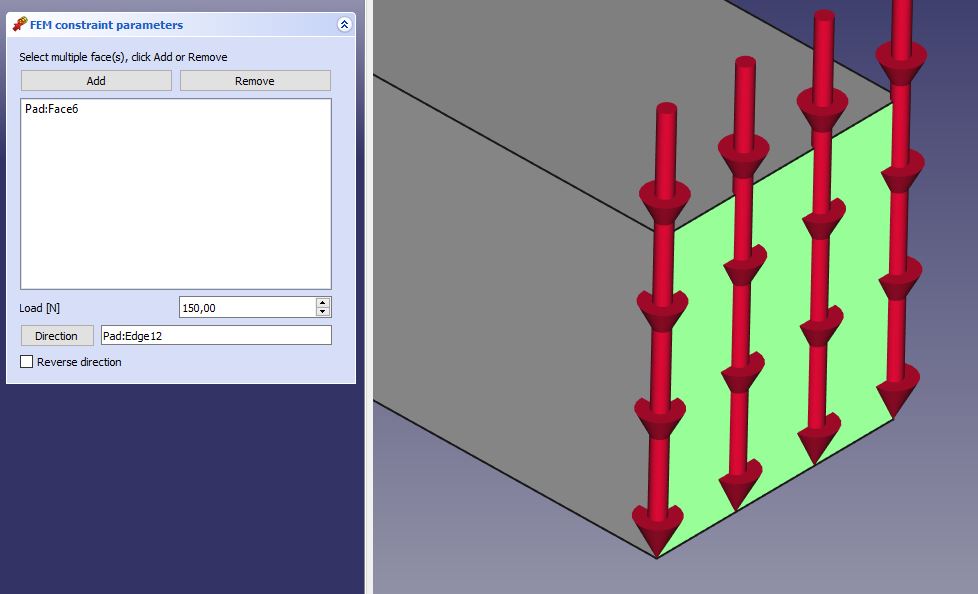FEM ConstraintForce/en: Difference between revisions
(Updating to match new version of source page) |
(Updating to match new version of source page) |
||
| Line 14: | Line 14: | ||
|MenuLocation=Model → Mechanical Constraints → Constraint force |
|MenuLocation=Model → Mechanical Constraints → Constraint force |
||
|Workbenches=[[FEM_Workbench|FEM]] |
|Workbenches=[[FEM_Workbench|FEM]] |
||
|Shortcut= |
|||
|SeeAlso=[[FEM_ConstraintPressure|FEM ConstraintPressure]] |
|SeeAlso=[[FEM_ConstraintPressure|FEM ConstraintPressure]] |
||
}} |
}} |
||
| Line 24: | Line 23: | ||
==Usage== |
==Usage== |
||
Applying a force to a face, line or point: |
|||
* In FEM workbench, click on [[File:FEM_ConstraintForce.svg|24px|Constraint Force]] or select {{KEY|Model}} → {{KEY|Mechanical Constraints}} → {{KEY|Constraint force}} to open Force Constraint properties dialog. |
|||
| ⚫ | |||
[[File:FEMForceConstraintProperties.PNG]] |
|||
| ⚫ | |||
| ⚫ | |||
| ⚫ | |||
** Click on a ''face'' to which a force should be applied. It will appear in the list of geometrical objects. |
|||
| ⚫ | |||
** Fill in {{KEY|Line load}} with a force value in [N] (attention: ''Not'' in [N/m]) |
|||
[[File: |
[[File:FEM ConstraintForce example.JPG]] |
||
| ⚫ | |||
| ⚫ | |||
| ⚫ | |||
==Notes== |
|||
Defined force is applied uniformly to selected objects. For example, if you define one force constraint with 200 N applied to two faces having the same area, each face will be uniformly loaded with 100 N. |
|||
2) Applying a force in to line in selected direction |
|||
** In FEM workbench, click on [[File:FEM_ConstraintForce.svg|24px|Constraint Force]] or select {{KEY|Model}} → {{KEY|Mechanical Constraints}} → {{KEY|Constraint force}} to open Force Constraint properties dialog |
|||
** If you have Mesh displayed, you need to hide it (select the mesh object and press {{KEY|spacebar}} or right click and select {{KEY|Hide item}}) and show the original model. |
|||
| ⚫ | |||
| ⚫ | |||
** {{KEY|Direction}}: Now, with line segment selected, it si likely that the force is applied in a wrong direction. We need to specify the direction by clicking the button {{KEY|Direction}} and then clicking a face pointing with its normal to the direction of the force (or reversed direction). Again, you can revert the direction of the force by clicking {{KEY|Reverse direction}}. |
|||
[[File:FEMforceonline.PNG]] |
|||
** Click {{KEY|Close}} to finish the dialog and create {{KEY|[[File:FEM_ConstraintForce.svg|24px]] ConstraintForce}} object |
|||
Revision as of 19:34, 8 November 2021
This documentation is not finished. Please help and contribute documentation.
GuiCommand model explains how commands should be documented. Browse Category:UnfinishedDocu to see more incomplete pages like this one. See Category:Command Reference for all commands.
See WikiPages to learn about editing the wiki pages, and go to Help FreeCAD to learn about other ways in which you can contribute.
|
|
| Menu location |
|---|
| Model → Mechanical Constraints → Constraint force |
| Workbenches |
| FEM |
| Default shortcut |
| None |
| Introduced in version |
| - |
| See also |
| FEM ConstraintPressure |
Description
This command applies a force of given value [N] to selected target geometry.
Usage
Applying a force to a face, line or point:
- In FEM workbench, click on
or select Model → Mechanical Constraints → Constraint force to open Force Constraint properties dialog.
- If you have Mesh displayed, you need to hide it (select the mesh object and press spacebar or right-click and select Hide item) and show the original model.
- Click on a face, line or point to which a force should be applied. It will appear in the list of geometrical objects.
- Fill in Load [N] with a force value in [N].
- Direction: In a typical case, you'll leave this field empty to apply a force in the normal direction. You can revert the direction of the force by clicking Reverse direction. In other cases, you need to pick a face/plane or edge, which serves as reference for force direction.
Notes
Defined force is applied uniformly to selected objects. For example, if you define one force constraint with 200 N applied to two faces having the same area, each face will be uniformly loaded with 100 N.
- Materials: Solid, Fluid, Nonlinear mechanical, Reinforced (concrete); Material editor
- Element geometry: Beam (1D), Beam rotation (1D), Shell (2D), Fluid flow (1D)
Constraints
- Electromagnetic: Electrostatic potential, Current density, Magnetization
- Geometrical: Plane rotation, Section print, Transform
- Mechanical: Fixed, Displacement, Contact, Tie, Spring, Force, Pressure, Centrif, Self weight
- Thermal: Initial temperature, Heat flux, Temperature, Body heat source
- Overwrite Constants: Constant vacuum permittivity
- Solve: CalculiX Standard, Elmer, Mystran, Z88; Equations: Deformation, Elasticity, Electrostatic, Electricforce, Magnetodynamic, Magnetodynamic 2D, Flow, Flux, Heat; Solver: Solver control, Solver run
- Results: Purge, Show; Postprocessing: Apply changes, Pipeline from result, Warp filter, Scalar clip filter, Function cut filter, Region clip filter, Contours filter, Line clip filter, Stress linearization plot, Data at point clip filter, Filter function plane, Filter function sphere, Filter function cylinder, Filter function box
- Additional: Preferences; FEM Install, FEM Mesh, FEM Solver, FEM CalculiX, FEM Concrete; FEM Element Types
- Getting started
- Installation: Download, Windows, Linux, Mac, Additional components, Docker, AppImage, Ubuntu Snap
- Basics: About FreeCAD, Interface, Mouse navigation, Selection methods, Object name, Preferences, Workbenches, Document structure, Properties, Help FreeCAD, Donate
- Help: Tutorials, Video tutorials
- Workbenches: Std Base, Arch, Assembly, CAM, Draft, FEM, Inspection, Mesh, OpenSCAD, Part, PartDesign, Points, Reverse Engineering, Robot, Sketcher, Spreadsheet, Surface, TechDraw, Test Framework
- Hubs: User hub, Power users hub, Developer hub
